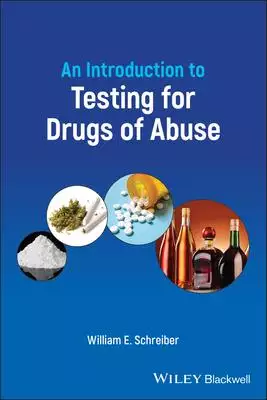Chemical potential e的問題,透過圖書和論文來找解法和答案更準確安心。 我們找到下列問答集和資訊懶人包
Chemical potential e的問題,我們搜遍了碩博士論文和台灣出版的書籍,推薦Schreiber, William E.寫的 An Introduction to Testing for Drugs of Abuse 和的 Nanobiotechnology in Neurodegenerative Diseases都 可以從中找到所需的評價。
這兩本書分別來自 和所出版 。
國立陽明交通大學 永續化學科技國際研究生博士學位學程 孫世勝、鄭彥如所指導 吳杰畢的 用於染料敏化電池的無金屬有機染料之結構設計 (2021),提出Chemical potential e關鍵因素是什麼,來自於染料敏化太陽能電池、輔助受體對、二丁基芴基、D-A-π-A、環戊二噻吩、有機染料、弱光照明。
而第二篇論文國立交通大學 生物資訊及系統生物研究所 尤禎祥所指導 謝明修的 布里斯洛中間體自由基反應機制之理論研究 (2021),提出因為有 布里斯洛中間體、反應機構、自由基、含氮雜環卡賓、轉酮醇酶的重點而找出了 Chemical potential e的解答。
An Introduction to Testing for Drugs of Abuse

為了解決Chemical potential e 的問題,作者Schreiber, William E. 這樣論述:
An Introduction to Testing for Drugs of AbuseAn Introduction to Testing for Drugs of Abuse presents a distilled set of facts about the major drugs of abuse that are encountered in clinical practice. Individual chapters highlight the similarities in chemical structure, mechanism of action, and phy
siologic effects of each drug group, as well as their metabolism, therapeutic uses and potential for misuse or abuse. Special attention is given to the testing process, with an emphasis on interpretation of test results.Informative and entertaining cases appear at the end of each chapter. These case
s illustrate the many situations in which drug testing is performed for medical, legal and employment purposes.Written in clear, concise language, this book provides practical guidance to pathologists, clinical chemists and technologists who are responsible for reporting and interpreting the results
of drug analyses. It will be especially useful to residents and students who are learning about toxicology for the first time. Clinical practitioners - doctors, nurses, pharmacists and other health care professionals - will find the information they need to order and interpret drug tests accurately
.For more information watch the trailer here: https: //players.brightcove.net/4931690914001/B1xdbomRDl_default/index.html?videoId=6310075842112
用於染料敏化電池的無金屬有機染料之結構設計
為了解決Chemical potential e 的問題,作者吳杰畢 這樣論述:
摘要第三代光伏的染料敏化太陽能電池 (DSSC)的興起,造成在過去的三十年中被廣泛地探索,因為它們具有的獨特特性,例如成本低、製造工藝簡單、輕巧、柔韌性好、對環境友善,並且在弱光條件下,仍具備突破性的高效率。儘管, DSSCs 依然有許多須待優化的部分,但藉由光捕獲染料光敏劑的分子結構設計,在優化 DSSCs 性能參數方面扮演關鍵的作用。因此,尋找符合DSSC需求的光敏染料,是該研究領域的關鍵研究方向之一。本論文的最終目標是在標準日照和弱光條件下,尋找高效穩定的有機光敏染料。這項工作是藉由無金屬有機光敏劑的系統結構工程來完成的,針對分子結構設計與光電特性的關聯及DSSC的效能表現。在本論文中
,我們已經合成了各種新型光敏染料,並對這些無金屬有機光敏染料進行了逐步的結構修飾,例如在單個敏化染料中引入一對輔助受體,在 D-A-π-A 框架中引入龐大的芴基實體,並增加共平面性以及延伸喹喔啉染料主要框架的共軛。通過使用各種光譜、電化學和理論計算來研究這些光敏染料的結構性質,以符合它們在DSSC主要特徵之應用前景。最後,在本論文中,我們展示了一組無金屬有機光敏劑,其元件效率高,在標準太陽照射下的效率超過 9%,在 6000 lux 的弱光照下,效率超過 30%,這將是一個具有未來發展潛力的結構設計,可以在沒有共吸附劑的情況下實現高效率。
Nanobiotechnology in Neurodegenerative Diseases
A PHP Error was encountered
Severity: Warning
Message: file_put_contents(/var/www/html/prints/public/images/books_new/F01/471/13/F014713570.jpg): failed to open stream: Permission denied
Filename: helpers/global_helper.php
Line Number: 140
Backtrace:
File: /var/www/html/prints/application/helpers/global_helper.php
Line: 140
Function: file_put_contents
File: /var/www/html/prints/application/views/article_v2.php
Line: 248
Function: coverWebp_online
File: /var/www/html/prints/application/controllers/Pages.php
Line: 662
Function: view
File: /var/www/html/prints/public/index.php
Line: 319
Function: require_once
A PHP Error was encountered
Severity: Warning
Message: getimagesize(/var/www/html/prints/public/images/books_new/F01/471/13/F014713570.jpg): failed to open stream: No such file or directory
Filename: helpers/global_helper.php
Line Number: 62
Backtrace:
File: /var/www/html/prints/application/helpers/global_helper.php
Line: 62
Function: getimagesize
File: /var/www/html/prints/application/helpers/global_helper.php
Line: 142
Function: coverWebp
File: /var/www/html/prints/application/views/article_v2.php
Line: 248
Function: coverWebp_online
File: /var/www/html/prints/application/controllers/Pages.php
Line: 662
Function: view
File: /var/www/html/prints/public/index.php
Line: 319
Function: require_once
A PHP Error was encountered
Severity: Notice
Message: Trying to access array offset on value of type bool
Filename: helpers/global_helper.php
Line Number: 64
Backtrace:
File: /var/www/html/prints/application/helpers/global_helper.php
Line: 64
Function: _error_handler
File: /var/www/html/prints/application/helpers/global_helper.php
Line: 142
Function: coverWebp
File: /var/www/html/prints/application/views/article_v2.php
Line: 248
Function: coverWebp_online
File: /var/www/html/prints/application/controllers/Pages.php
Line: 662
Function: view
File: /var/www/html/prints/public/index.php
Line: 319
Function: require_once
A PHP Error was encountered
Severity: Notice
Message: Trying to access array offset on value of type bool
Filename: helpers/global_helper.php
Line Number: 66
Backtrace:
File: /var/www/html/prints/application/helpers/global_helper.php
Line: 66
Function: _error_handler
File: /var/www/html/prints/application/helpers/global_helper.php
Line: 142
Function: coverWebp
File: /var/www/html/prints/application/views/article_v2.php
Line: 248
Function: coverWebp_online
File: /var/www/html/prints/application/controllers/Pages.php
Line: 662
Function: view
File: /var/www/html/prints/public/index.php
Line: 319
Function: require_once
A PHP Error was encountered
Severity: Notice
Message: Trying to access array offset on value of type bool
Filename: helpers/global_helper.php
Line Number: 68
Backtrace:
File: /var/www/html/prints/application/helpers/global_helper.php
Line: 68
Function: _error_handler
File: /var/www/html/prints/application/helpers/global_helper.php
Line: 142
Function: coverWebp
File: /var/www/html/prints/application/views/article_v2.php
Line: 248
Function: coverWebp_online
File: /var/www/html/prints/application/controllers/Pages.php
Line: 662
Function: view
File: /var/www/html/prints/public/index.php
Line: 319
Function: require_once

為了解決Chemical potential e 的問題,作者 這樣論述:
This book focuses on neurodegenerative diseases which have become a major threat to human health. Neurodegenerative diseases are age related disorders and have become increasingly prevalent in the elderly population in recent years. Hence, there is an urgent need to study and develop new strategies
and alternative methods for the treatment of neurodegenerative diseases. This book showcases the promises that nanobiotechnology brings in research, diagnosis, and treatment of neurodegenerative diseases. It is very beneficial for varied group of readers including nanotechnologists, biotechnologists
, pharmacists, medical professionals, bioengineers, biochemists and researchers working in this field. Nanobiotechnology in Neurodegenerative Diseases include various chapters including neurodegeneration and neurodegenerative diseases, nanotechnology for the rescue of neurodegenerative diseases, pro
mising potential of nanomaterials for diagnosis and therapy of neurodegenerative diseases, nanotechnology mediated nose-to-brain drug delivery, and formulation and characterization of intranasal nanoparticles of antiretroviral drugs. Dr. Mahendra Rai is Senior Professor and UGC-BSR Faculty Fellow
at the Department of Biotechnology, Sant Gadge Baba Amravati University at Amravati, Maharashtra, India. He was a Visiting Scientist at the Department of Bioenergetics, University of Geneva, Switzerland and at the Department of Plant Protection of Debrecen University, Debrecen, Hungary. He visited D
epartment of Chemical Biology, University of Campinas, Brazil under Indo-Brazil Research Programme (DST-CNPq collaboration). He was visiting Professor in Nicolaus Copernicus University, Torun, Poland. He was invited by State University of Campinas, Brazil. Moreover, he was also visiting professor in
Ostrava, Czech Republic. His area of expertise includes microbial biotechnology and nanobiotechnology. His present research interests are nanobiotechnology in medicine, agriculture and bioethanol production. He has published more than 400 research papers in national and international journals. In a
ddition, he has edited/authored 50 books and 6 patents. Dr. Alka Yadav, is a Post Doctoral fellow with Prof Mahendra Rai. She has completed her Master’s and Doctoral degree in Biotechnology from Sant Gadge Baba Amravati University, Amravati, Maharashtra, India. She has nine years experience in writi
ng reviews, research articles and book chapters. She has published several research and review articles in high impact factor journals. She also has many book chapters to her credit. She has received the award for the most cited article by Elsevier for the article Silver nanoparticles: as a new gene
ration of antimicrobials published in Biotechnology Advances. She has also worked as guest reviewer with publications like Wiley Publications, Elsevier and SAGE Publications. She has a process patent to her credit entitled "Processo de obtencao deum filme basedo em compositos de polisasacarideos de
prata, filme obtido e uso". Her areas of interest include Plant Biotechnology, Mycology, Nanobiotechnology, Myconanotechnology and Nano-antimicrobials.
布里斯洛中間體自由基反應機制之理論研究
為了解決Chemical potential e 的問題,作者謝明修 這樣論述:
含氮雜環卡賓(N-heterocyclic carbene)催化之化學反應中,布里斯洛中間體(Breslow intermediate)扮演重要的催化角色。布里斯洛中間體能以親核基(nucleophile)或自由基(radical)之形式參與反應。本論文探討布里斯洛中間體之自由基特性及形成機制(mechanism),其自由基可從氫自由基轉移或直接氧化形成。安息香縮合反應(benzoin condensation)中,布里斯洛中間體將氫原子轉移至苯甲醛(benzaldehyde)以形成自由基,此自由基可結合形成安息香產物,或排除反應之副產物,使其重新進入催化反應。唯此路徑之反應能障高於傳統非自
由基路徑。此研究亦探討四種布里斯洛中間體之不同電子組態的位能面。其中烯醇鹽(enolate)形式能產生偶極束縛態(dipole-bound state),此為產生自由基之新路徑;拉電子基(electron-withdrawing group)以及立體障礙基(bulky groups)可穩定基態。另外,我們亦研究布里斯洛中間體之碎片化(fragmentation)與重組(rearrangement)。布里斯洛中間體之催化反應可能因其碳氮鍵斷裂而中止,形成碎片。我們證實其反應中可以形成自由基,亦可形成離子。反應趨向之路徑與布里斯洛中間體之羥基的質子化型態有關。碎片化反應亦可視為轉酮醇酶(tran
sketolase)中之噻胺(thiamin)催化反應中之副反應;此研究證實轉酮醇酶透過限制布里斯洛中間體之結構與質子化型態,使其碳氮鍵斷裂需更高之反應能量,進而抑制此副反應。